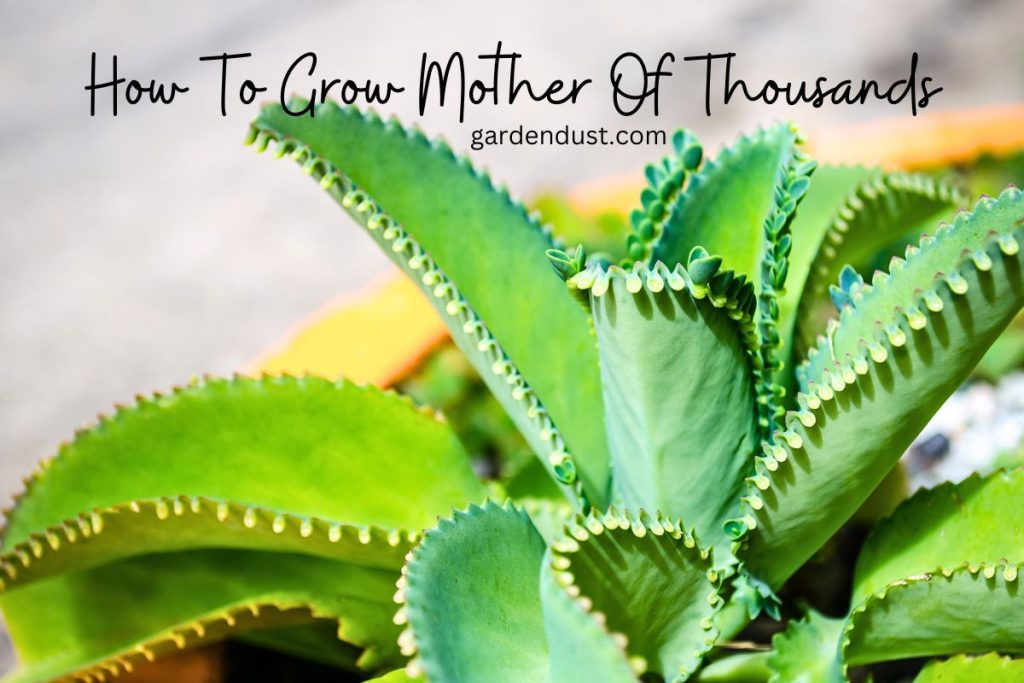Mother of Thousands, scientifically known as Kalanchoe daigremontiana, is a unique and fascinating succulent that has captured the hearts of plant enthusiasts around the world. Its distinctive feature lies in its ability to produce numerous tiny plantlets along the edges of its leaves, giving rise to its intriguing name. In this comprehensive guide, we will explore the art of cultivating How To Grow Mother Of Thousands(Kalanchoe Daigremontiana), from selecting the right plant to providing optimal care for its growth and propagation.
Botanical Name-Kalanchoe daigremontiana
Native- Madagascar
Genus-Kalanchoe
Common Name- Mother of Thousands, Mexican Hat Plant, Alligator Plant
Family-Crassulaceae
Plant Type- Succulent
Plant Size-Height-1 to 2 feet (30 to 60 cm) & Spread-2 to 3 feet (60 to 90 cm)
Grow Care for Mother of Thousands
Sunlight
Mother of Thousands (Kalanchoe Daigremontiana) thrives in bright, indirect sunlight. While it can tolerate some direct sunlight, prolonged exposure may lead to leaf burn. Position the plant in a location where it receives at least six hours of indirect sunlight daily. A sunny windowsill with filtered sunlight is an ideal spot. During intense summer heat, consider protecting the plant from harsh afternoon sun to prevent stress.
Water
Proper watering is crucial for the health of Mother of Thousands. Allow the top inch (2.5 cm) of the soil to completely dry out before watering again. Water the soil around the base of the plant rather than directly on the leaves to minimize the risk of fungal issues. Provide deep, thorough watering sessions, ensuring water drains from the bottom of the pot. During the dormant period in fall and winter, reduce watering frequency, and slightly increase it during the active growing season in spring and summer.
Fertilizer
Mother of Thousands benefits from regular fertilization during the growing season. Use a balanced, water-soluble fertilizer formulated for succulents, and apply it every 4-6 weeks. Dilute the fertilizer to half strength to avoid overfeeding. Refrain from fertilizing during the plant’s dormant period in fall and winter. This feeding routine will provide the essential nutrients for robust growth and overall plant health.
READ ALSO:-HOW TO PROPAGATE STRING OF HEARTS: 4 METHODS & CARE
Soil
Selecting the right soil is crucial for Mother of Thousands, as they require well-draining conditions. Choose a succulent or cactus mix that includes components like perlite or sand. This type of soil prevents waterlogging, reducing the risk of root rot. Ensure the pot has drainage holes to facilitate proper water drainage. Repot the plant if you notice the soil becoming compacted or if the roots outgrow the current container. This will provide the necessary space and aeration for healthy root development.
Repotting
Repotting Mother of Thousands is essential for maintaining its health and accommodating growth. Choose a slightly larger pot with drainage holes, water the plant lightly before repotting, and gently remove it, checking for root health. Trim any damaged roots, place the plant in fresh succulent mix, and water sparingly after repotting. This process not only prevents root crowding but also provides an opportunity to propagate new plants from offsets or leaves, ensuring the continued vibrancy of your Mother of Thousands.
Propagation
Propagating Mother of Thousands (Kalanchoe Daigremontiana) is a straightforward and rewarding process. One common method involves utilizing the plantlets that form along the edges of the leaves. Gently detach these tiny offsets and plant them in a separate container with well-draining succulent or cactus mix. Ensure that the offsets have developed roots before transplanting to improve their chances of successful establishment. Another propagation technique involves taking leaf cuttings: carefully remove a healthy leaf, allow the cut end to callus for a day or two, and then plant it in the same type of well-draining soil. Water sparingly until roots develop, typically within a few weeks. Whether using offsets or leaf cuttings, the propagation of Mother of Thousands offers a delightful way to expand your succulent collection or share these unique plants with fellow gardening enthusiasts.
Common Pests And Disease
Mother of Thousands (Kalanchoe daigremontiana) is generally hardy, but like any plant, it can face certain pests and diseases that may impact its health. Common pests include spider mites and aphids, which can be problematic if not addressed promptly. Spider mites often manifest as tiny dots on the leaves and create fine webbing, while aphids cluster on the undersides of leaves, sucking plant juices. Combat these pests with regular inspection and, if necessary, treat them with insecticidal soap or neem oil. Additionally, watch for signs of root rot, a condition resulting from overwatering or poorly draining soil. Yellowing or wilting leaves, accompanied by a foul odor, may indicate root rot. To mitigate this, ensure well-draining soil, water sparingly, and promptly address any signs of stress or decline in your Mother of Thousands to maintain its overall vitality.
Cultivating Mother of Thousands, the intriguing Kalanchoe daigremontiana, can be a rewarding and enjoyable experience for plant enthusiasts. By providing the right growing conditions, proper care, and understanding its unique propagation methods, you can witness the fascinating life cycle of this captivating succulent. With a little attention and patience, your Mother of Thousands will thrive, producing a beautiful display of tiny plantlets that adds a touch of nature’s marvel to your indoor garden. Happy Gardening…







